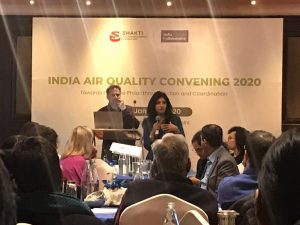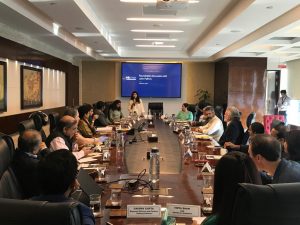One of the panellists as AVPN 2020 was Shloka Nath, Executive Director of the recently-formed India Climate Collaborative (ICC). As one of the conference themes was collaboration, she talks to Alliance about how ICC puts the concept into practice, what its aims and purpose are, about how climate issues play into the development of the global south and about the double aspect of the COVID-19 pandemic on climate change.

Shloka Nath, Executive Director of the India Climate Collaborative
What’s the genesis of the India Climate Collaborative? Why did it come about now?
Three years ago in 2017, I was appointed to lead and establish the sustainability portfolio at the Tata Trusts, which is one of the leading philanthropic organisations in India and there was a move to start thinking about climate change from the perspective of overarching quality of life. We’d been working in a number of fields that were related to climate change, things like agriculture, livelihood, sanitation, etc., but we hadn’t embedded a climate lens in our work, nor were we directing any funds directly to climate change. What I realised was that the challenge of starting to think about climate change more broadly and what we could do in that space wasn’t unique to the Tata Trusts. Through the research that we did, we learned for instance that less than 10 per cent of philanthropic funding in India goes towards climate change. So over the course of the next year, as we were building up the portfolio, we spent a lot of time trying to understand what the entry barriers and challenges were for the rest of the sector and we realised that they were high and numerous. To give you an example, there’s a tremendous lack of technical expertise. No-one had the tools they required to build in a climate lens across their portfolio. A second challenge is creating a common baseline around the understanding of climate so that when I say ‘climate’ and you say ‘climate’, we’re referring to the same thing.
You said in your session at the conference that India and developing countries in general had particular problems stemming from climate change. Could you elaborate on that? There’s a broader narrative around climate change in India which I think is a really fascinating opportunity as well, because India is still writing its development story and how we weave climate into that narrative is going to be very different to the way it’s perceived in the west. In the west, it’s perceived as a technocratic challenge. It’s one that’s driven around emissions with very clear targets. In India, it’s much more of a human impact story. It’s deeply woven into our economic growth. It’s a livelihood story, it’s a story about vulnerable populations and it’s going to be that way for the global south, so how we in India choose to shape that narrative will have big implications for the whole of the global south and that, in turn, will shape the global narrative.

Photo credit: India Climate Collaborative.
Did the impetus for a collaborative rather than an initiative purely of the Tata Trusts come from your view of this?
It came from what we learned about the current gaps. The ICC grew out of the Trusts’s sustainability portfolio and is one of our key initiatives because we realised that in order to meet the tremendous entry barriers that philanthropic actors were facing, they’d have to do it together on a platform that would ideally de-risk entry and hopefully drive further investment and engagement with the state. No one actor operating on its own, including the Trusts, could do that. So collaboration became a means by which to build capacity for philanthropy and now we’ve expanded the original group to include businesses and other actors like government agencies, etc. What we’re doing is trying to build solution providers, rather than solutions per se because if you scale solution providers, then you help them do what they’re doing but better and at scale. It’s not a regular collaborative. What we’re trying to do is really capacity building on four levels. On one end, the ICC does seek to fill in the gaps in the Indian climate ecosystem – inadequate research and data, for instance. There has to be more refined policy-making and infrastructure and implementation of those policies. We need more public engagement on the issue. We need to drive more funding in the space. Those are your regular systemic gaps. They’re not just true for climate, they’re true for many other development sectors. The second element of our work is building the capacity of actors to drive more funding towards these challenges and collaboration is a means to do that. Members can learn from each other, they can create a shared knowledge network, there are opportunities to strategically align around co-funding and, that way, you avoid replication in the system as well. You can leverage each other’s strengths in a way that you can’t if you are working solo and you can cover far larger geographies and a much broader range of constituents if you bring actors together on a collaborative platform.
The third aspect of capacity building is for the actors themselves so that they can act on climate change, and the fourth is the ICC in and of itself. Bringing together a myriad of actors across philanthropy, government, business and civil society, research and academia has in itself been an act of capacity building for the Indian ecosystem. It’s the largest private philanthropic collaboration in India.
At the core of the work of all the actors or funders of the ICC are vulnerable populations and building in their resilience as well as trying to mitigate the effects of climate change is part of that.
You talked about it bringing in the other sectors as well. Who else is involved?
It’s a mix of Indian corporate and private philanthropy as well as some major international foundations. There are around 20 of them altogether and they are the co-founders of the ICC, so they support the institution as well as the programme. Then we have a broader network of members or affiliates. They constitute the wider funder community of philanthropies, impact investors, government agencies, etc. – whoever comes in but is not necessarily funding the structure of the ICC but is engaged with the network and looking to engage on programmes. Finally, we have a very strong and wide network of what we call partners and they are essentially other collaboratives and networks, like AVPN, or again government agencies, civil society implementers or NPOs working on the ground, and this is not just restricted to India, they include many actors involved in the international community, so we’re really hooked up to the global climate community as well and we work closely with them.
So the core group of 20, are they all foundations or philanthropists of one sort or another? Yes, except that funding includes CSR so they are corporate philanthropists, but they represent their business arms. The way giving is structured in India, it’s not an investment from a private company but it does come in through CSR, so we have very strong representation from the private sector.
And what sort of sums of money are we talking about?
I’d rather not say, only because we’ve been particular about not getting into those details because it then becomes about the funding rather than the number of actors.

Photo credit: India Climate Collaborative.
Do you fund programmes or is it mainly about driving the field, rather than picking out individual initiatives?
It’s both. We do fund programmes of our own. The caveat here is that we are not a regranter. We’re not structured to pass through grants to NPOs or civil society actors. We give grants to organisations doing, for instance, research or creating knowledge that will help our members with capacity building, or initiatives that will drive more membership engagement around climate change or more funding towards climate change. There are also things ICC will fund just because no-one is going there yet. If it’s an area we want people to start looking at, we may make that first move and de-risk investment.
You mentioned that part of your work is to bring more visibility to the field in India. What kind of traction are you getting with the media, or with people generally taking more notice?
There are two answers to that question. When we launched in January this year, we got coverage in over 55 publications and we were on TV news all over the country. One reason for that is that we have a very strong track of cultivating climate change leadership in India. It’s about how to ensure there are voices that are going to amplify the message. As in a lot of Asian countries, we have living donors, so our philanthropists are very active.
Another thing is COVID-19. In countries like India, you have a generation now who have never lived with clean skies, who have never seen walkable streets in their cities and because of the lockdown – the consequences of which have been devastating, I don’t want to make light of that in any way – but there has been this other aspect to it that it has suddenly provided blue skies, it has provided opportunities to bike or walk or think about liveability in different ways than we could never have imagined before. Because we are living in that afterworld, people have begun to say, ‘look, if we did X, Y and Z and we cleaned up air pollution and we worked from home instead of always commuting to work, what would that world look like?’ So climate seems to have come home in a way that it never did earlier.
And the final thing is that we have had the most apocalyptic series of events since lockdown. The worst locust attack in decades has hit the northern regions of the country and has decimated farmers’ crops. We’ve had two major cyclones on the east coast of India and in Mumbai which have wrought havoc. The Arabian Sea is not associated normally with cyclones but thanks to climate change and the warming of the Indian Ocean we’re starting to see more cyclonic activity. Finally, heatwaves are increasing year on year and because of the pandemic, people have had the opportunity to sit at home and reflect on all of this in a way they never have before, so climate has become embedded in conversations about recovery. What COVID-19 has done is exposed the gaps in the system, the very same gaps that will be revealed in any future shocks coming from climate change and it’s showed us what we need to do to bridge those gaps.
I was going to ask – there are two possible contrasting effects of COVID-19 on climate change. On one hand, the pandemic might distract attention from the climate issue, on the other, it might sharpen people’s attention and make them realise that, although COVID-19 has been disruptive, things will be much worse if climate change reaches catastrophic proportions. It sounds like you see the second possibility is happening more than the first.
I think it’s a bit of both. You’re right, it has been hugely disruptive. For example, COP was supposed to take place this year and it’s been pushed back to next year. That’s a big missed opportunity. It’s almost as if all the countries who made commitments to the Paris Agreement have been given an extension and it’s an extension we can’t afford. But on the other hand, within the tragedy, there are these slivers of hope which offer an opportunity to broaden that consciousness about how we need to think about our future collectively.

Photo credit: India Climate Collaborative.
You talked about building the leadership capacity of prominent philanthropists in the climate change issue. How do you factor the voices of ordinary Indians into your work?
At the core of the work of all the actors or funders of the ICC are vulnerable populations and building in their resilience as well as trying to mitigate the effects of climate change is part of that. By building the capacity of those actors to engage in this work and to better serve those populations, we build in greater representation of those populations because we are trying to prepare everyone who works with them and for their benefit to get better at doing what they are doing. Climate change affects virtually all philanthropic work, so climate-linked health issues or reduction in agrarian incomes can lead to reduced school attendance and learning outcomes and, in a country like India, where you have big populations living under the poverty line who are really very exposed to climate risks, it’s an issue that can really affect development outcomes. There’s no pathway to development that doesn’t involve climate.
So if you aren’t listening to vulnerable populations, you aren’t serving them and development falls to the ground?
Exactly.
Indian politics is very polarised at the moment. How does that affect your work?
We do want to align with the mission of the government. It has very similar aims to us in what it’s trying to do to build resilience into society. No matter what the political agendas may be, I think that’s a very core commonality with our mission and our mandate and that’s really where I see a lot of opportunity for collaborating with the government. And, of course, government itself is one of the actors for whom we want to build capacity. There’s a strong case to be made for government working with civil society because, at the end of the day, when it comes to grassroots work and networks, civil society has been embedded in local populations and communities for decades and in some ways they understand them better than anyone else. The government can leverage the expertise they’ve developed from the work they’ve been doing on the ground for all that time on all kinds of development outcomes – nutrition, health, livelihoods, whatever it may be. It doesn’t have to reinvent. What the government has is reach and scale on a level that no-one else can match, and if it can just build on that small percentage of philanthropic money that is going into X community, district or area, but is really doing revolutionary work, and leverage it to scale interventions across the country, that’s where there’s huge scope to work together.
Often though, Indian state and civil society seem to be at odds. How do you overcome that?In the past, and still today, if you talk about environmental NGOs and civil society, there is still this adversarial relationship and that’s because it grew out of movements in India in the ‘70s and ‘80s which were very activist-led. Today, that has changed and is changing, and civil society wants to work with government and build its capacity, but the nature of that relationship has yet to catch up with the reality on the ground. We have to proactively reframe that relationship and I think that the interesting transitional framing around climate change is that the trajectory used to be environment and climate change. Today its development and climate change, that’s the lens. That’s a huge change and, as I said earlier, when you apply that climate lens to the work that you are doing, you realise that there is really nothing that is not touched by climate change.
There are also things ICC will fund just because no-one is going there yet. If it’s an area we want people to start looking at, we may make that first move and de-risk investment.
It’s a truism to say that the amount of resources philanthropy and social investment can bring to the problem are fairly modest. What do you see as the most significant contribution they can make?
It’s often not the amount of funding, it’s the strategic imperative behind that funding because what philanthropic capital can be, and what no other form of capital can be, is incredibly catalytic. It’s patient, it can take long-term bets, it can go into areas and de-risk them, where others will not go. It comes with tremendous credibility and leverage and often plays the role of bringing a diverse set of actors together simply because its interests are aligned towards the betterment of society. So, it may be small but it’s incredibly powerful. It’s not just money, it’s influence, it’s a host of non-monetary factors that go into making philanthropic investment really crucial.
One of the key themes of the conference was collaboration and obviously that’s your basis, too. How do you see the importance of network like AVPN in this issue?
They play a crucial role in the ecosystem. I think what they’ve done is absolutely fantastic in bringing together a really diverse range of actors across many geographies to interact on a range of development issues, not just climate. You need umbrella bodies like that that can weave multiple narratives together as well as bringing a variety of perspectives into the room. I think that’s how we all grow, learn and of course source opportunities. It’s a huge learning environment and that’s really what a network should be.
Given that this year’s conference was exclusively online, how did you feel it worked?
I think it was brilliant. When you come together for a conference, there are really five outcomes that everyone focuses on. One is to network, the second is to expand your knowledge and to find solutions to the problems you’re working on, the third is to present your ideas and to work with others, the fourth is for people to meet you and the fifth is really learning beyond your own field or interest and thinking what are the other avenues for exploration. They hit all five. I think that speaks to their success, the fact that they could create a similar learning environment virtually to what they do live. I’m sure there are aspects of what they’ve learned from going virtual that they’ll continue even when things open up again.
Andrew Milner is associate editor of Alliance magazine
-
- Read Alliance magazine’s coverage of AVPN’s 2020 Virtual Conference.
- For more on this topic check out Alliance’s climate commitment at alliancemagazine.org/climate






Comments (0)